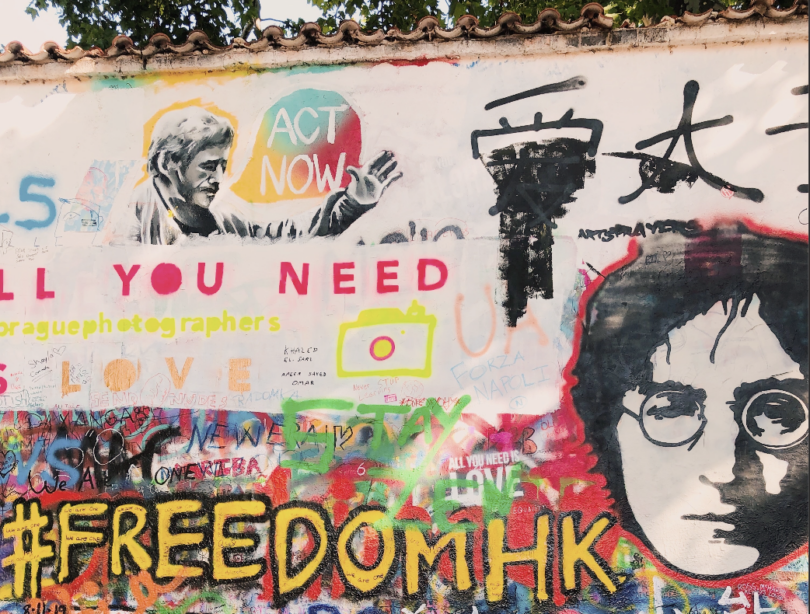PRAGUE – I first plastered on the Lennon Wall in Prague in the summer of 2019, during the height of the anti-extradition law protests at home in Hong Kong.
Four years later, I revisited the political mural during Youth Journalism International’s Global Conference, only to face a puzzling sea of streetwear brands stickers and celebrity posters.
I wondered whether the graffiti in support of Hong Kong’s democracy movement was buried, replaced or erased.
It may be more comforting to think of the Lennon Wall as an ever-evolving art space, as a hub for artistic freedom and continuing political activism from all around the world.
Begun as a memorial mural for John Lennon following his 1980 assaination, the wall with a single image of the Beatles singer and some lyrics was soon transformed into a collaborative space, filled with graffiti, stickers and banners.

The deceased Lennon might wonder, as I did, of where his face had gone on the wall. As a result, perhaps, a group of art students called ‘Prague Services’ attempted to ‘restore’ the original Lennon Wall in 2014 by painting it white and writing the quote ‘Wall is over,’ as an allusion to Lennon’s 1970s ‘War is Over’ peace campaign.
To their dismay, some accused them of vandalizing the wall symbolic of creative and political freedom. The immaculate white was soon buried as well.
To the Lennon Wall and the ‘artists’ decorating it, perhaps the ‘Stand with Hong Kong’ slogans are not so dissimilar to Bitcoin advertisements and smiley-face stickers. Nonetheless, to Hongkongers, the Lennon Wall holds a special place in their hearts.
During the 2014 Umbrella Movement in Hong Kong, protestors took inspiration and installed a ‘Lennon Wall’ outside of the Central Government Complex using colorful Post-it Notes.
In the 2019-2020 anti-extradition law protests, ‘Lennon Walls’ in Hong Kong ‘blossomed everywhere’ (a slogan used by supporters to call upon city-wide actions), with more than 150 installations across the city.
The police started tearing them down, erasing the art and even arresting people who put Post-it Notes on these walls.
Still, ‘Lennon Walls’ in support of Hong Kong’s democracy continued to blossom, both at home and abroad, with similar murals appearing in Taipei, London, Toronto, Sydney and more.

Of course, Hong Kong protestors once left their presence on the original Lennon Wall in Prague as well. Graffiti such as ‘liberate HK’ and ‘#FreedomHK’ were seen all over the Lennon Wall as protestors developed the so-called international front to further the fight for democracy at home by garnering international support.
Though as the graffiti disappeared over time, so did the international spotlight on the protests in Hong Kong.
I continued to wonder where the ‘Stand with Hong Kong’ slogan went as I stood in front of the Lennon Wall. I then discovered a single sanitary pad stuck on the wall. While it could be a powerful symbol for menstrual health and human rights, I would not be surprised if it was simply put up as a joke by some school kids who visited.
Regardless, it raises questions about what art is, what differentiates street art from vandalism and freedom of expression.
When a Chinese student covered up the old graffiti in London’s Brick Lane and spraypainted the ‘core socialist values’ of the Chinese Communist Party, it sparked controversy and much political backlash.
As a comment reads on yiqueart, the artist’s Instagram account, “Obstructing freedom of speech is not a part of freedom of speech.”
What ‘Prague Services’ and the ‘artists’ of the Lennon Wall did was not so different in nature to the Chinese student at Brick Lane – covering previous artwork with new artwork.
It occurred to me that it is only a matter of time before the “Stand with Hong Kong” slogan will be buried and replaced.
As the graffiti for Hong Kong’s democracy was covered over by Black Lives Matter, then by slogans about the protests over Mahsa Amini’s death in Iran and the Israel-Hamas War and more, the Lennon Wall in Prague is evolving by the day, by the moment.
It is, however, not obliteration, not the removal of all traces of the previous artwork. While the previous artwork might be buried and no longer physically retrievable, the particular moment captured by the Lennon Wall is where its significance lies.
As with any political moment, it is impossible for any artwork to remain in the spotlight on the Lennon Wall forever.
Rather than erasure of the past, the Lennon Wall is about how political art evolves over time and makes its own moment in history.
Joanne Yau is a Reporter with Youth Journalism International from Hong Kong. She wrote this commentary.
Gemma Christie is a Reporter with Youth Journalism International from England. She contributed a photograph.





